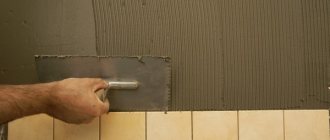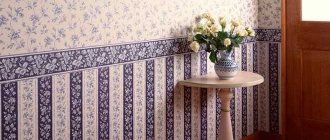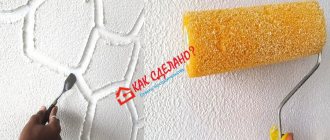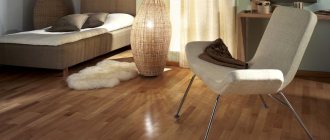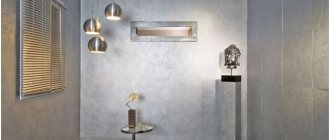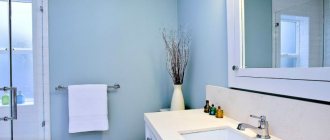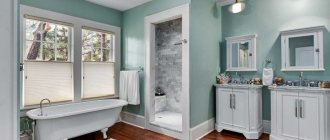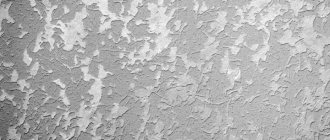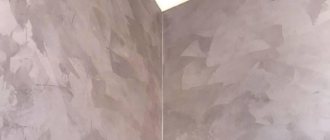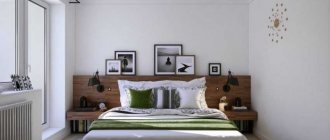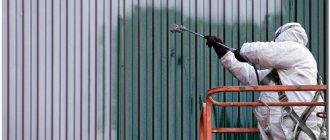Pros and cons of decorative paint
Decorative wall paint can create certain visual effects; such material can imitate stone, wood, or silk.
Compared to other finishing materials, this wall paint has the following advantages:
- With proper care, this finishing material will last several times longer than wallpaper or decorative plaster.
- When painting, no joints are formed, so the surface of the walls looks like one solid canvas.
- Available in a wide range of colors and effects.
- Has a high level of resistance to high humidity.
- If desired, you can repaint without removing the old layer of paint.
- Regardless of the type of surface, the paint is applied in a uniform layer.
- If you use water-based decorative paint for walls, it can be used for decoration in a children's room or bedroom, as it is considered environmentally friendly.
There is only one disadvantage to decorative paint for walls - the walls must be well prepared with a perfectly flat surface.
Performance properties of textured wall paint
In addition to its decorative ability, it has many advantageous differences from standard types:
- Excellent dimensional stability and ductility ensure reliable resistance to foundation shrinkage during the first years of operation of housing in new buildings. Due to its resistance to external factors, the textured paint coating does not crack or peel over many years of use.
- High light transmittance indicates stable exposure to the sun. When exposed to ultraviolet radiation, wall coverings ideally retain their original color and tone.
Textured paint is suitable for rooms with high humidity
- The excellent heat resistance of the finishing material allows it to be used in rooms with dynamic temperature changes and high levels of humidity. Thanks to this property, the walls do not become moldy and are reliably protected from the spread of fungi harmful to health.
- The ability to repel dust and not absorb odors creates an impeccable microclimate in the room, which has a beneficial effect on the well-being and health of others.
Textured paint has excellent resistance to external factors
The high concentration of modified starch in the base of the textured paint determines the thickness of the mixture. Due to the dense base, it can easily take on any desired look under the influence of a roller with a shaped nozzle. Thanks to the volumetric layer, before painting there is no need to use finishing putty, perfectly level the walls or eliminate small cracks and all kinds of roughness. A thick coating will easily hide all sorts of minor imperfections on the surface.
Textured wall paint masks all wall defects
Types of decorative paint
Depending on the composition and properties, decorative wall paint is available in several types.
Acrylic
The most popular decorative paint for walls, which does not have a specific aroma and is suitable for all types of surfaces.
This type of paint dries quickly enough and forms a protective film.
- Acrylic decorative paint for walls is considered safe for health, environmentally friendly, durable and most resistant to temperature changes.
- Available with various effects: matte, pearl, gloss.
Latex decorative paint
It has a high level of resistance to high humidity and is able to hide some defects in the wall surface.
- This type of paint can be diluted with ordinary water, it dries quickly and is quite resistant to mechanical damage.
- It is worth noting that with frequent exposure to direct sunlight, latex paint loses its tone.
Water-based
One of the most budget-friendly types of paints, but at the same time it has good properties.
- The main advantages of this material: low paint consumption when applied to the surface, safe for health, and good permeability to moisture.
- It is worth considering that water-based paint is washed off the surface quite quickly.
Oil paint
It has the brightest possible tone and forms a durable layer when applied. It is worth noting that this type of paint has a sharp, specific aroma and is available for sale in a very narrow range of colors.
It should also be taken into account that oil-based decorative paint requires a lot of consumption when applied to the surface and has a high cost.
Silicone decorative paint
It is considered a universal material, which is characterized by a high level of resistance to high humidity. If you apply this paint in 2 layers, you can hide minor dirt; when it dries, a protective film against abrasion appears.
Silicate
Paint that contains liquid glass so that the coating has a high level of strength and vapor permeability. This decorative paint is characterized by maximum resistance to high humidity and temperature changes.
Which color and style to choose
In order for the room to evoke only pleasant emotions after painting, you need to choose the right colors or their combinations. It is better to strive for your own desires, rather than follow fashion, because it changes almost every year. Here are the most popular paint colors and their purposes:
- white - ideal for ceilings, small rooms, visually expands the boundaries;
- beige is a very popular color, suitable for all types of interiors, looks better in combination with contrasting tones;
- black - reduces space, is used only as an accent, otherwise it will make the room gloomy;
- gray – looks stylish, gives coziness, can become a background for walls, but definitely requires dilution with more “cheerful” tones;
- red is an aggressive color, used in interiors with caution, practically not used in bedrooms and children’s rooms;
- yellow is an excellent color for creating bright spots and diluting a boring environment, especially recommended for northern rooms;
- orange – gives a feeling of warmth, harmony, encourages communication, is popular in the living room and kitchen;
- brown is a classic color in the interior; beige and peach shades go well with it;
- blue – gives a feeling of relaxation, calm, sets the mood for relaxation, its light shades are well suited for the bedroom;
- purple - used accentuated, as in the dark version it can cause a feeling of fatigue;
- green – calms, gives a feeling of closeness to nature, suitable for the living room, bedroom.
Room decoration styles may vary. Depending on the style direction, it is worth choosing both the shade option and the type of wall painting. Here are the most popular interior styles:
- Modern. Usually walls are painted in one or two shades; a popular combination of rich tones with white and beige colors is popular. Stripes and ornaments on the walls work well. The palette should be unobtrusive.
- Minimalism. Plain coloring is used in colors such as blue, gray, white. Textured paints and moldings are used.
- Loft. Typically the design includes brown, gray, black tones. Often a wall painted “like brick” is introduced.
- Classic. The interior can be decorated in any color, preferably pastel colors with ornaments, monograms, and gilding.
- Provence. Blue, lilac, mint tones, pink and peach shades are used. The walls can be plain or striped; artistic painting is popular.
- Country. Stone textures, mustard, white, brown tones, antique effects and whitewash are used.
Tools for applying decorative paint
To paint walls with decorative paint, you should prepare more than one type of tool:
- Paint roller;
- Brush;
- Spatulas;
- Sponges;
- Hard brush;
- Sandpaper;
- Stencils for forming a pattern.
You can use a standard paint roller, a textured one with a pattern.
With a brush you can create quite original textures, which depend on the width and shape of the brush.
Necessary tools for painting work
Painting work is easy to do yourself using the necessary tools. This does not require special skills or expensive equipment.
List of required tools:
- Spatula, scraper and sandpaper for cleaning the wall from remnants of old wallpaper, chalk, lime, adhesive drips, leveling sagging and bumps.
- A small brush with round or rectangular natural bristles will be needed for painting corners and hard-to-reach places.
- A foam roller, a roller with a corrugated rubber base, or a spray gun for applying material to the surface.
- Rectangular shallow container for a roller.
You can remove streaks or drops with a sponge or cloth.
How to prepare walls for painting
Before you start applying paint to the surface of the walls, they should be carefully prepared.
If painting is happening for the first time, then you need to take the following steps:
- Remove old coating from the wall surface.
- Treat the walls with primer.
- Carefully inspect the walls, note the presence of defects.
- All defects should be filled with putty and then sanded.
- Apply a coat of primer.
Allow the walls to dry completely before applying a coat of paint.
Technology of using interior paints
Textured wall paint has endless potential. The thick mixture is easy to modify and apply to a plane. It is indispensable if you want to disguise small cracks and create a masterly relief on the coating. The technology for its use is extremely simple and accessible to any connoisseur of non-trivial finishing methods.
Experienced painters advise:
- Pre-clean the coating from traces of old paint or wallpaper. Fill large cracks with putty and prime the base several times.
Prime the base before painting
- Finish the wall with a specialized structural roller or wide spatula. These painting tools ideally distribute textured paint along the entire perimeter of the surface.
Textured paint roller
- When covering a wall with two colors, the top layer is applied using a paint sprayer or spray cans. These finishing methods greatly simplify and speed up the painting process.
The second layer can be applied using a paint sprayer
- If you want to create a unique texture, you need to add sawdust, coal or glass chips, crushed dry leaves, quartz sand, small pieces of ceramic mosaic or other solid granules. To add shine and secure decorative elements after the paint has dried, the coating must be opened with acrylic varnish or specialized wax.
To create a unique texture, add stone chips
- To decorate walls with original textures, it is worth using non-standard finishing methods - using a sponge, comb, broom, piece of fabric, smooth or chaotic movements of the fingers.
Applying textured paint with a sponge
- When working with paints and varnishes, you must wear rubber gloves and safety glasses.
Textured wall paint allows you to achieve antique styling when using paints and varnishes with metallized and textile effects. This is relevant when arranging the interior in the traditions of palace styles: Baroque, Empire, Art Deco or Rococo. Textured mixtures with imitation of natural coatings are modern elements of non-standard finishing. They can be used when decorating interiors in eco, modern, country, avant-garde or rustic styles.
Textured paint for walls with imitation of natural coatings
Knowing the features of textured paint and the possibility of modifying its composition, you can endlessly conduct design experiments and independently create filigree wall decor. Unique relief coverings with hand-made patterns and ornaments will emphasize the sophistication and exclusivity of the interior design, regardless of the chosen stylistic direction of design.
Techniques for applying decorative paint
Experts note that decorative paint can be applied to walls using a variety of techniques, which differ in appearance and the painting process itself:
- Stippling is a special technique for applying decorative paint that creates the appearance of an old, shabby surface. As a rule, decorative acrylic paint is used for this technique. It is also worth considering that if there are any bulges or cracks on the surface of the wall, they will become more noticeable with this type of painting.
- Leather effect is a popular technique for applying decorative paint to wall surfaces. Most often, this technique is used when decorating a study, library, office... As a rule, latex-type decorative paint is used to create a leather effect.
- The Venetian plaster effect is one of the most beautiful techniques for applying decorative paint in which only a plastic spatula is used. For this technique it is recommended to use latex paint.
- The silk effect is one of the most sophisticated techniques for applying decorative paint, which is often used when decorating a living room or bedroom. As a rule, it is recommended to use acrylic-based paint for this effect.
Ornament is a popular technique for painting walls with decorative paint, which is painted with 2 paints of different tones, one of them is applied with a textured roller.
Horizontal division - when a dark tone of paint is applied at the bottom of the wall, and a light color at the top. It is worth noting that narrow stripes can be applied around the perimeter of the walls.
Stencils - used when painting walls with decorative paint to create a specific pattern. Using stencils is quite easy and any type of paint can be used for painting using this technique.
Combination with other materials
It happens that in one room the paint is combined with other types of decoration. This helps make the design approach more creative.
Wallpaper and painting
Usually, only one accent wall is decorated with paint or wallpaper, and the others are finished with a second material. Some wallpapers can be used for painting, which will also serve as an interesting solution for a bedroom, office, or living room.
Photo wallpaper and painting
If one wall is covered with photo wallpaper, the rest can be painted. In this case, it is not recommended to use intricate painting techniques, since the photo panel already attracts enough attention.
Plastering and painting
Decorative plasters are covered with paint so that the walls are embossed and evenly colored. You can also combine “bark beetle”, other types of textured plasters and painted walls in the interior of a bathroom or hallway.
Wood and painting
Wooden walls trimmed with panels, lining, timber look good next to painting in the interior of country houses and attics.
Stone and painting
This combination is very typical for decorating the fireplace area, country style kitchen in the apron area. Also, the combination of stone and paint looks good in such style directions as Provence and loft.
Brick and concrete walls with painting
It is better to paint such surfaces with acrylic, latex, and alkyd paints. Artificial aging, drips, artistic strokes, and duets of contrasting colors look original.
Brick and paint
Usually the brick is red or white, less often colored. It can be coated with matching paint to enhance the brightness of the main shade or tinted in any suitable color.
3D panels and painting
Typically, such panels are used in modern interior styles. For them, a single color color is enough to make the design stylish, but not pretentious.
Drywall
Painting drywall is very popular. If you seal the joints well, the result will be perfect, because the walls and ceiling are smooth and have no flaws. You can use any, even the most complex, techniques on drywall.
Tips for working with decorative paint
Professional painters give several recommendations that should be taken into account when working with decorative wall paint:
- Before you start painting, it is necessary to thoroughly prime the surface of the walls, otherwise mold may appear over time.
- When painting walls, it is recommended to cover the entire floor surface with a protective film.
- After opening the paint, you need to mix it well and only then begin the process.
- When painting with a brush, it is recommended to initially apply the paint in horizontal and then vertical stripes.
- If painting is done with a roller, the first strokes should still be applied with a brush.
- Textured paint is best applied in a thick layer.
Preparing the walls
Painting the walls in an apartment is easy to do with your own hands. The painting technology itself is quite simple, but the result will please you only with high-quality surface preparation. If wallpaper can hide minor imperfections and defects, then paint, especially matte, will only highlight them. Only textured materials can hide pits and small irregularities, but ordinary paints cannot do this. The problems of the walls will be especially noticeable in good lighting: they will immediately catch the eye.
To prepare the walls for decorative finishing, you need to do the following:
- clean the base from the old coating, especially from smooth paints;
- repair all defects and putty if necessary;
- sand the walls well;
- apply primer in 2-3 layers.
You can start painting only when all layers of the rough finish are completely dry, otherwise the paint will apply unevenly and will not last long.
Photo of decorative painting of walls in the interior
Removing old coating
The easiest way would be to get rid of the wallpaper. It will be enough to pick them up around the corner and tear them off. Those parts that remain on the wall will need to be wetted and, after limpness, pryed off with a spatula.
It is more difficult with painted walls. Especially if it is an old “Soviet” oil paint, which does not adhere to water-based paints. To get rid of it, follow the advice of professionals:
If the paint begins to peel, remove it. You can first tap the wall; in those places where you hear a dull sound, there are voids and the paint will sooner or later fall out along with the new coating. It must be pryed off and removed.
Oil-based paint can be removed using a special solvent or after heating with a hair dryer. If the paint holds tightly, it will be enough to sand it with sandpaper and prime it.
Decorative effect “Sea foam” Putty “Alba”
The elegance of palace and castle styles, which since ancient times was created with expensive silk fabrics, can now be achieved using Alba putty-paint.
The effect of decorative plaster, called “Sea Foam,” combines a truly elegant and charming variety that is sure to impress anyone, even the most capricious and picky taste. Short review
Required material and its consumption per m2
- Primer paint “Uno-Decor”, 160g
- Decorative acrylic putty “Alba”, 300g
Required tools and related products
- Microfiber roller
- Trowel "Venice"
- Stainless steel spatula
- Round iron
- Masking tape
Necessary base preparation
Maximum leveled surface, prepared for painting, reinforced with fiberglass.
Type of decorative surface
Decorative paint
Drying time
24 hours
Decoration should be carried out strictly according to the instructions:
- Using a fiber roller, apply an even coat of base color, Uno-Decor paint, tinted to match the finish.
- After 8-12 hours, a layer of Alba decorative paint is applied with a Venetian trowel using chaotic strokes. After 3-4 square meters, you should return to the beginning and create the effect of “Sea Foam” decorative plaster using a round trowel. Docking between areas should be done using the dry to wet technology. The edges of each layer should be ragged.
- A day after the first layer of Alba has dried, apply the next one, following the principle of the first, but changing the direction and overall pattern. Due to such changes, you get intricate overlaps of each wave, which creates the effect of sea foam. After partial drying, smoothing with a trowel for decorative work “Venice” is allowed.
- The use of protective varnish is allowed 24 hours after Alba putty has dried, but is not mandatory.
Chic sea shimmers and unobtrusive patterns will fit perfectly into any interior style, be it classic, loft or high-tech. Decoration technology does not require professionalism. All you need to do is attend our master class on applying the decorative plastering effects you require.
The price of Alba acrylic putty and the graceful effect of sea foam starts from 600 rubles per square meter.
Alba putty Sample 01
Alba putty Sample 02
Alba putty Sample 03
Alba putty Sample 04
Alba putty Sample 05
Alba putty Sample 06
Shop "Plaster" and
Luxurious interiors and monumental building facades, characterized by enormous durability, resistance to various destructive factors, as well as being environmentally friendly and safe, are the merit of the manufacturer of the premium segment of decorative materials Mascarade, as well as the competent work of the specialists of the online service “Plaster”. You can buy any of the decoration products by calling our numbers, filling out an online application on the website or visiting the sales office and show room. We always have a huge range of decorative coatings, professional tools, as well as tinting of any volume in the shortest possible time (no more than 3 minutes/5 kg bucket).
TOP 5 effects of decorative plaster for interior decoration
When decorating the interior, any person wants to choose the best effect of decorative plaster. However, there is no one best effect, because everyone's tastes are different. We have selected for you the TOP 5 best effects of decorative plaster used in interior decoration.
01Venetian plaster Classic - “Polished marble”
02Swahili paint – “Sandy wind”
03Plaster Marakesh - “Pearl”
04Plaster Traverto Noa – “Map of the World”
05Alba putty – “Sea foam”
Below is a description of each of the effects of decorative plaster.
Decorative effect “Polished marble” “Venetian plaster Classic”
The effect of decorative plaster, called “Polished Marble,” is achieved using a simple but labor-intensive technology for applying Venetian plaster.
Short review
Required material and its consumption per m2
- Universal soil, 80-150 grams
- Venetian plaster “Classic”, 0.3 – 1 kg
- Masco Wax, 50-100 grams
Required tools and related products
- Venetian trowel
- Venetian spatula
- Japanese spatula
- Sandpaper P2000
- Angle grinder with felt disc
- Masking tape
Necessary base preparation
A surface leveled for painting, using fiberglass or fiberglass.
Type of decorative surface
Venetian plaster
Drying time
24 hours
Creating this effect of decorative plaster is carried out in several stages:
- Apply a uniform, thin layer of Venetian over the entire surface to the pre-primed surface using the “scrape” method using a Japanese spatula or Venetian trowel. It will serve as a color base. If you are making a combined color scheme, use light colors as a base. After 12 hours, sand any prominent elements or bumps with sandpaper, and also treat the entire surface, then wipe with a damp cloth to remove dust particles.
- The second layer is applied in a chaotic manner using a Venetian trowel or Japanese spatula, creating a cross pattern with the color base. When combining colors, use a minimum amount of dark shades, because... they will help create a beautiful texture similar to natural marble. Let the layer dry for 2-3 hours.
- After each layer has dried (except for the first layer - the color base), it is necessary to iron the surface. Holding the Venetian trowel almost parallel to the surface, polish using a criss-cross motion, using minimal force at the beginning and maximum force at the end of the trowel's path. After a mirror-like shine appears on the surface, proceed to the next step.
Subsequent layers of Venetian are applied based on your desire. The more layers, the deeper the pattern. Maximum number of layers – 10
- The final stage will be waxing. The wax is applied with a trowel in an even layer over the entire surface. After 24 hours it is polished using a sanding machine with a felt attachment. Polishing can also be done with a fur mitten.
The result of your work is a luxurious surface reminiscent of natural marble, cut and skillfully polished by stone craftsmen. In addition to the incredible beauty of this decorative plaster effect
, you get a huge baggage of characteristics - water resistance, maintainability, resistance to mechanical stress. In addition, the Venetian is very difficult to stain, but extremely easy to clean. And the durability of at least 15 years will make you forget about the hassle you went through during the renovation.
The price of polished marble depends on the application method, the number of layers and consumption, ranging from 300 rubles per m2.
Venetian plaster Sample 1
Venetian plaster Sample 2
Venetian plaster Sample 3
Venetian plaster Sample 4
Venetian plaster Sample 5
Venetian plaster Sample 6
Decorative effect “Pearl” Plaster “Marakesh”
Studying the stunning and enchanting interior look created using the effect of Marakesh decorative plaster, called “Pearl,” you can’t help but get the feeling that such work is only possible for painting professionals with high experience.
However, this is just a misconception. In our office you can acquire decorating skills absolutely free. Short review
Required material and its consumption per m2
- Primer Acryl-Primer, 200g
- Decorative plaster Marakesh, 0.6-1kg/layer
- Varnish Matte, 50-100g.
- Valencia varnish, 50-150 g
Required tools and related products
- Trowel "Venice"
- Stainless steel spatula
- Sea sponge
- Decorative sponge
- Masking tape
Necessary base preparation
A smooth, durable surface prepared for painting, preferably reinforced with fiberglass.
Type of decorative surface
Textured (relief) decorative plaster
Drying time
24 hours
Obtaining the effect of decorative plaster is achieved using the following method:
- The surface is first impregnated with Acryl-Primer to remove dust and improve the adhesion of the material.
- After the soil has dried, Marakesh decorative plaster is applied using a trowel and spatula in an even thin layer and left to dry for 12 hours. After the prescribed time, apply the second layer of the “Pearl” decorative plaster effect using a sea sponge using the tamponing technique. After a few minutes, smooth the surface. When working on a large area, it is recommended to leave a “torn edge” to connect the fragments.
- After 24 hours, Matte and Valencia varnishes are applied, carefully soaking the decorative sponge. The sequence of matte and glossy varnishes is at your discretion.
The effect of Marakesh decorative plaster, called “Pearl,” has an impressive list of parameters inherent in modern finishing materials. In addition to the aesthetic beauty of semi-precious polished stone, you get moisture and water resistance, resistance to damage, environmental friendliness and durability for at least 15 years. The material is also repairable, which is a huge advantage over tiles, wallpaper and plastic.
The price of Pearl - the effect of Marakesh decorative plaster depends on the colors and shades of varnishes, their use in general, as well as the thickness of the layers and the severity of the relief, from 300 rubles per square meter.
Plaster Marakesh Sample 01
Plaster Marakesh Sample 02
Plaster Marakesh Sample 03
Plaster Marakesh Sample 04
Plaster Marakesh Sample 05
Plaster Marakesh Sample 06
Decorative effect “World Map” Plaster “Traverto Noa”
The world map is one of the most popular decorative plaster effects due to its relief and variety of shades and colors.
It can be tinted or covered with glazing and tinting compounds. Thanks to the lime base, it has a beneficial effect on the microclimate. It can withstand contact with water and frost, but is not a façade material. Short review
Required material and its consumption per m2
- Primer Acryl-Primer Quartz, 250g
- Decorative plaster Traverto Noa, 1.4-2kg/layer
- Varnish Matte, 50-100g
Required tools and related products
- Trowel "Venice"
- Stainless steel spatula
- Decorative sponge
- Masking tape
Necessary base preparation
Leveled, durable surface, prepared for painting, reinforced with fiberglass.
Type of decorative surface
Textured (relief) decorative plaster
Drying time
24 hours
Recreating the effect:
- Treat the surface to be decorated with a quartz primer, white or tinted to match the coating. This will improve the adhesive characteristics (stickiness of the material), and also normalize the consumption and water absorption capacity of the base.
- Using a trowel, apply an even layer of Traverto decorative plaster over the entire surface. It should become uniformly rough, resembling a surface plastered with cement mortar. Leave to dry for at least a day.
- Using a Venetian trowel and spatula, bring to life the effect of decorative plaster, creating islands on the surface that resemble the silhouettes of islands and continents on a world map. After a few minutes, smooth the islands until smooth. The work must be carried out from corner to corner, without interruption.
- After 24 hours, matte varnishes are applied in the combination of colors that you initially chose to create the effect of decorative plaster. It is also possible to use wax to make the surface waterproof.
The amazing result of your work will be reflected on the walls with incredible elegance. Also, many modern effects are created from Traverto, such as “antique wall” or “art concrete”. It is possible to use travertine to imitate brickwork or a natural concrete surface.
The price of the “world map” effect depends on the thickness of the applied layer and the use of varnishes, starting from 500 rubles/m2.
Plaster Traverto Noa Sample 01
Plaster Traverto Noa Sample 02
Plaster Traverto Noa Sample 03
Plaster Traverto Noa Sample 04
Plaster Traverto Noa Sample 05
Plaster Traverto Noa Sample 06
Varieties by composition
Wall finishing material fillers have different features, functional and technical properties. If this is an option for decorating surfaces with gypsum or lime, then you can safely count on their strength. Such mixtures are usually used to finish the ceiling between beams in interior styles: Provence, country, chalet, vintage, retro, loft. Or when plastering sections of walls to look antique.
Decorative plaster in eco-style living room interior Source behance.net
Additional additives for decoration, creating an unusual coating:
- metallized threads;
- crushed shells;
- large cellulose fibers;
- pigments and colors.
Any decorative marble plaster in the living room, dining room, or hallway will not only beautifully recreate a beautiful pearlescent-shiny surface, but will also reliably protect the walls from various aggressive external factors. Neither mechanical damage, nor chemicals or detergents will damage the integrity of the coating. A number of other types of additives to plaster have the same or different properties.
Glossy marble plaster on the walls of the living room Source odnastroyka.ru
